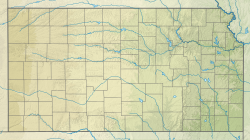| White Rock Creek | |
|---|---|
| Native name | Riviere Amiable (French) |
| Location | |
| Country | United States |
| State | Kansas |
| Physical characteristics | |
| Source | |
| • location | Republic County, Kansas |
| • coordinates | 39°57′19″N98°40′01″W / 39.9552912°N 98.6670128°W [1] |
| Mouth | Republican River |
• location | Jewell County, Kansas |
• coordinates | 39°55′10″N97°51′21″W / 39.9194550°N 97.8558765°W [1] |
• elevation | 1,473 ft (449 m) |
White Rock Creek is a river in the central Great Plains of North America. A tributary of the Republican River, it flows through northern Kansas.
